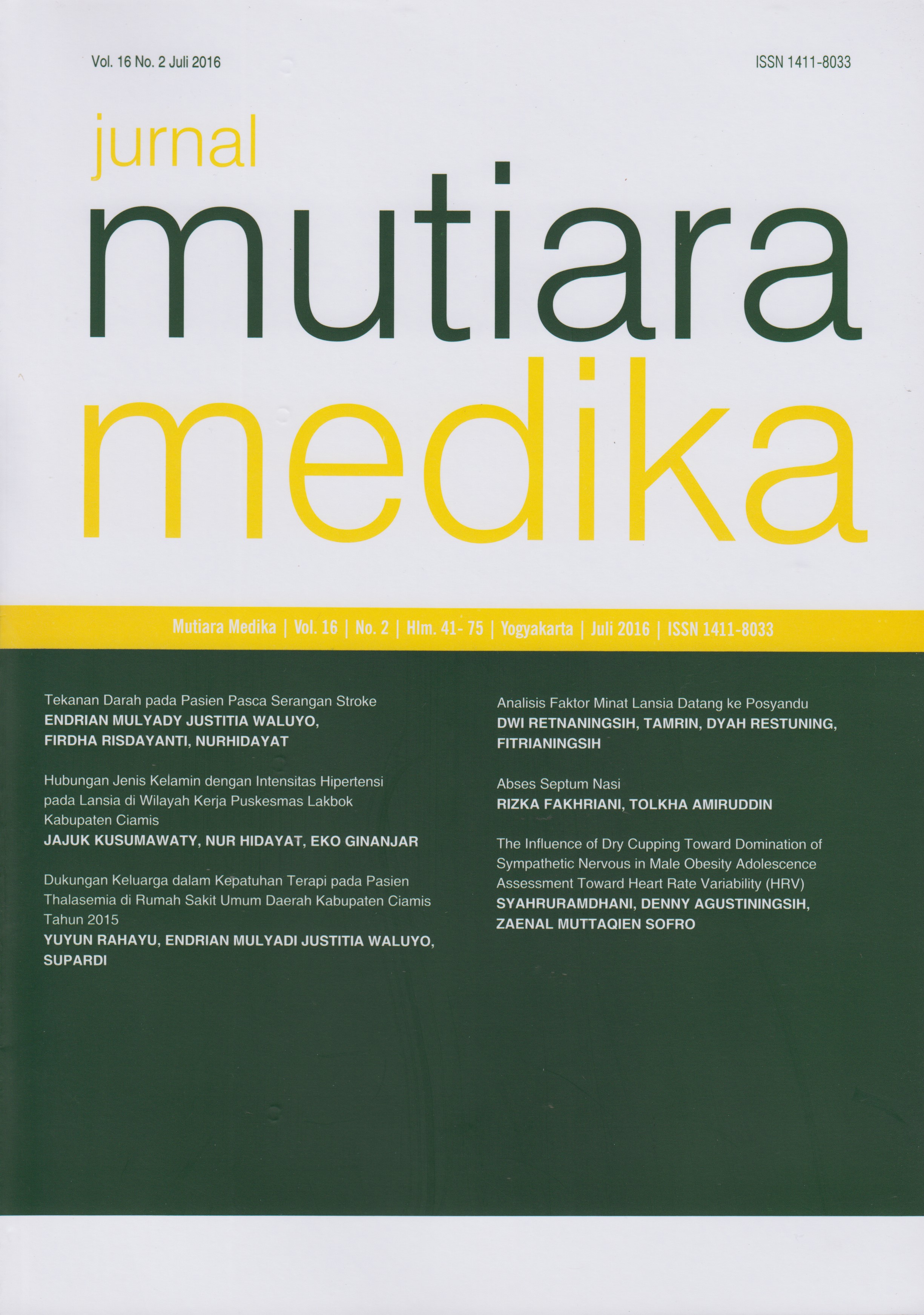Abses Septum Nasi
DOI:
https://doi.org/10.18196/mmjkk.v16i2.4453Keywords:
nasal septal abcess, nasal trauma, children, abses septum nasi, trauma hidung, anakAbstract
Abses septum nasi merupakan kasus yang jarang dijumpai. Trauma nasal diketahui sebagai penyebab dari abses septum nasi. Penanganan dini dari penyakit ini sangat penting karena dapat menimbulkan komplikasi yang serius. Pada makalah ini, kami akan melaporkan kasus anak dengan abses septum nasi dengan kecurigaan traumatik. Pasien laki-laki, berusia 9 tahun, datang dengan keluhan hidung tersumbat yang dirasakan sejak 5 hari sebelum masuk rumah sakit (SMRS). Keluhan disertai nyeri hidung, keluar sekret dan demam. Pada pemeriksaan fisik, didapatkan kedua kavum nasi sempit, terdapat pembengkakan septum nasi bilateral dengan permukaan licin, berwarna kemerahan serta terdapat nyeri tekan dan fluktuasi yang konsisten dengan abses septum nasi. Tatalaksana yang dilakukan adalah insisi drainase dan pemberian antibiotik. Pasien kontrol tujuh hari setelahnya dan pemeriksaannya dalam batas normal. Diagnosis dini dan tatalaksana yang tepat sangat penting pada penyakit ini untuk mencegah terjadinya penyebaran infeksi dan komplikasi berat yang dapat menimbulkan gejala sisa.Nasal septal abscess is uncommon. Nasal trauma is known to be a causative factor for development of nasal septal abscess. Early intervention is important as it can cause serious complications. In this case, we will present a child with nasal septal abscess with suspicion on trauma. A 9-year-old male was presented with nasal obstruction since 5 days before presentation. The patient also complained nasal pain, secretions, and fever. On physical examination, there were bilateral nasal cavity fullness and nasal septum swelling, consistent with a nasal septal abscess. Drainage incision and antibiotic administration were done seven days after interventions, the clinical findings were within normal limit. Early diagnosis and management is important to prevent the spread of infection and severe complications which may cause some sequelae.
References
Alshaikh N, Lo S. Nasal Septal Abscess in Children: from Diagnosis to Management and Prevention. Int J Pediatr Otorhinolaryngol, 2011; 75 (6): 737–744.
Huang YC, Hung PL, Lin HC. Nasal Septal Abscess in An Immunocompetent Child. Pediatr Neonatol, 2012; 53 (3): 213–5.
Takano K, Abe A, Kakuki T, Himi T. A Nasal Septal Abscess in a Pediatric Patient. J Case Reports in Medicine, 2014; 3 (1): 1-2.
Nwosu J, Nnadede P. Nasalseptal Hematoma/ Abscess: Management and Outcome an a Tertiary Hospital of a Developing Country. Patient Prefer Adherence, 2015; 9 (1): 1017–21.
Cheng LH, Kang BH. Nasal Septal Abscess and Facial Cellulitis Caused by Community-Acquired Methicillin-Resistant Staphylococcus aureus. J Laryngol Otol, 2010; 124 (9): 1014-6.
Debnam JM, Gillenwater AM, Ginsberg LE. Nasal Septal Abscess in Patients with Immunosuppression. Am J Neuroradiol, 2007; 28 (10): 1878–1879.
Naik SM. Nasal Septal Abscess: A Retrospective Study of 20 Cases in KVG Medical College and Hospital, Sullia. Clin Rhinol An Int J, 2010; 3 (3): 135–40.
Jatana KR. Delayed Presentation of Nasal Septal Abscess in a Pediatric Patient Following Infectious Mononucleosis and Acute Bacterial Sinusitis Otorhinolaryngology. Int J Otorhinolaryngol, 2017; 4 (1): 1–3.
Kass JI, Ferguson BJ. Treatment of Hematoma of the Nasal Septum. N Engl J Med, 2015; 372 (22): e28(1-3).
Sowerby LJ, Wright ED. Intracranial Abscess As a Complication of Nasal Septal Abscess. CMAJ, 2013; 185 (6): 1.
Downloads
Issue
Section
License
Copyright
Authors retain copyright and grant Mutiara Medika: Jurnal Kedokteran dan Kesehatan (MMJKK) the right of first publication with the work simultaneously licensed under an Attribution 4.0 International (CC BY 4.0) that allows others to remix, adapt and build upon the work with an acknowledgment of the work's authorship and of the initial publication in Mutiara Medika: Jurnal Kedokteran dan Kesehatan (MMJKK).
Authors are permitted to copy and redistribute the journal's published version of the work (e.g., post it to an institutional repository or publish it in a book), with an acknowledgment of its initial publication in Mutiara Medika: Jurnal Kedokteran dan Kesehatan (MMJKK).
License
Articles published in the Mutiara Medika: Jurnal Kedokteran dan Kesehatan (MMJKK) are licensed under an Attribution 4.0 International (CC BY 4.0) license. You are free to:
- Share — copy and redistribute the material in any medium or format.
- Adapt — remix, transform, and build upon the material for any purpose, even commercially.
This license is acceptable for Free Cultural Works. The licensor cannot revoke these freedoms as long as you follow the license terms. Under the following terms:
Attribution — You must give appropriate credit, provide a link to the license, and indicate if changes were made. You may do so in any reasonable manner, but not in any way that suggests the licensor endorses you or your use.
- No additional restrictions — You may not apply legal terms or technological measures that legally restrict others from doing anything the license permits.






